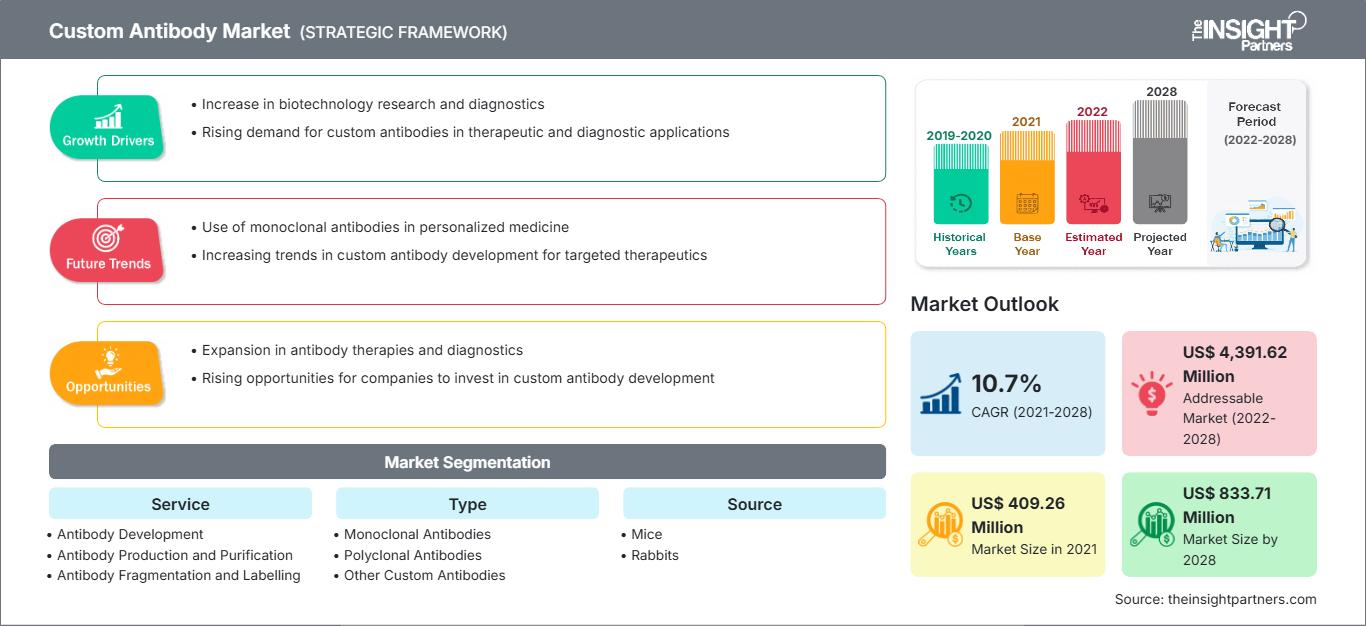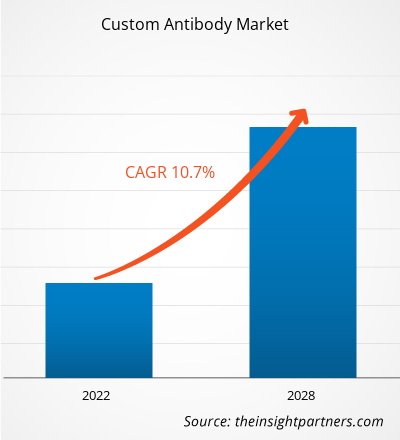Le marché des anticorps personnalisés était évalué à 833,71 millions de dollars américains en 2028, contre 409,26 millions de dollars américains en 2021 ; sa croissance devrait atteindre un TCAC de 10,7 % entre 2021 et 2028.
Des anticorps personnalisés peuvent être générés chez la souris, le rat ou le hamster, afin de répondre aux besoins de tous les hôtes. Les entreprises proposent une large gamme d'anticorps adaptés aux besoins des chercheurs. Il existe une variété d'anticorps personnalisés sur le marché, notamment des anticorps polyclonaux et monoclonaux, des anticorps monoclonaux recombinants, des anticorps d'hybridomes, des anticorps recombinants polyclonaux, etc. Les entreprises proposent des services d'assistance complets pour tous les types et toutes les étapes de la production d'anticorps, depuis la conception et la synthèse des peptides, la conjugaison des protéines porteuses jusqu'à l'immunisation animale, la collecte de sérum ou la fusion d'hybridomes, l'analyse des titres et la purification finale des anticorps.
La croissance du marché des anticorps sur mesure est due à des facteurs tels que la forte demande en recherche, le soutien croissant des gouvernements, l'évolution constante des profils de maladies, la multiplication des partenariats public-privé et l'augmentation des activités de financement, qui améliorent considérablement les performances de la biotechnologie. Cependant, la production d'anticorps monoclonaux et polyclonaux varie selon les animaux utilisés pour les produire. Le coût, également déterminé par les packages d'anticorps sur mesure demandés pour différentes applications et proposés par différents acteurs, freine la croissance du marché.
Personnalisez ce rapport en fonction de vos besoins
Vous bénéficierez d’une personnalisation sur n’importe quel rapport - gratuitement - y compris des parties de ce rapport, ou une analyse au niveau du pays, un pack de données Excel, ainsi que de profiter d’offres exceptionnelles et de réductions pour les start-ups et les universités
Marché des anticorps personnalisés: Perspectives stratégiques

- Obtenez les principales tendances clés du marché de ce rapport.Cet échantillon GRATUIT comprendra une analyse de données, allant des tendances du marché aux estimations et prévisions.
Aperçu du marché : Services de production et de développement offerts par les fournisseurs d'anticorps personnalisés
Vous bénéficierez d’une personnalisation sur n’importe quel rapport - gratuitement - y compris des parties de ce rapport, ou une analyse au niveau du pays, un pack de données Excel, ainsi que de profiter d’offres exceptionnelles et de réductions pour les start-ups et les universités
Marché des anticorps personnalisés: Perspectives stratégiques

- Obtenez les principales tendances clés du marché de ce rapport.Cet échantillon GRATUIT comprendra une analyse de données, allant des tendances du marché aux estimations et prévisions.
Plusieurs entreprises proposent activement des services de recherche et développement d'anticorps personnalisés. Quelques-uns de ces services lancés par ces entreprises sont mentionnés ci-dessous.
- En juin 2021, GenScript a annoncé le lancement de son service MonoRab, un anticorps monoclonal de lapin (mAB) personnalisé. Il s'ajoute à la gamme intégrée de services d'anticorps premium de l'entreprise. MonoRab est la technologie exclusive de l'entreprise qui utilise la combinaison des technologies d'hybridome et du séquençage précoce d'anticorps monoclonaux. Ces deux technologies produisent des mAb de lapin personnalisés plus spécifiques et possédant une affinité plus élevée, ainsi que des capacités diversifiées requises pour un large éventail d'applications.
- En mars 2021, Giotto Biotech a lancé des services spécialisés de production d'anticorps polyclonaux et monoclonaux. L'entreprise facilite la production de plus de 500 types d'anticorps monoclonaux pouvant être utilisés pour des applications diagnostiques et thérapeutiques. Français Il offre un large choix d'espèces comme sources d'anticorps polyclonaux.
- En novembre 2020, AMSBIO a annoncé des services de développement d'anticorps monoclonaux recombinants de lapin et de souris. Le développement d'anticorps monoclonaux recombinants repose sur la plateforme de développement DimAb, qui est différente des technologies conventionnelles de fusion d'hybridomes. Elle a la capacité d'isoler les gènes IgG des cellules B d'animaux immunisés. Ces anticorps contribuent au développement et à la commercialisation de médicaments sur le marché. En octobre 2019, la FDA a approuvé le premier médicament dérivé d'anticorps monoclonaux de lapin : Beovu. Beovu est destiné au traitement de la dégénérescence maculaire liée à l'âge (DMLA) humide.
- En mars 2020, Absolute Antibody Ltd a annoncé le lancement d'un service de production d'anticorps recombinants à haut débit pour son FleXpress. Français L'entreprise propose à ses clients des services facilitant l'expression rapide de nombreux anticorps, jusqu'à un volume de 80 ml, ainsi que pour propulser la capacité de production afin de répondre à la demande croissante en technologie d'anticorps recombinants.
Ces services de production d'anticorps personnalisés proposés par les entreprises accélèrent la croissance du marché.
Informations basées sur les services
Sur la base du service, le marché des anticorps personnalisés est segmenté en développement d'anticorps, production et purification d'anticorps, et fragmentation et marquage d'anticorps. En 2020, le segment du développement d'anticorps détenait la plus grande part du marché et devrait croître à un TCAC important au cours de la période de prévision.
Informations basées sur le type
Sur la base du type, le marché des anticorps personnalisés est segmenté en anticorps monoclonaux, anticorps polyclonaux et autres anticorps personnalisés. En 2020, le segment des anticorps monoclonaux détenait la plus grande part du marché, tandis que le segment des anticorps polyclonaux devrait croître au cours de la période de prévision.
Informations basées sur la source
Selon la source, le marché des anticorps personnalisés est segmenté en souris, lapin et autres. Le segment des souris détenait la plus grande part du marché en 2020, tandis que le segment des souris devrait enregistrer le TCAC le plus élevé du marché au cours de la période de prévision.
Informations basées sur les domaines de recherche
Selon le domaine de recherche, le marché des anticorps personnalisés est segmenté en oncologie, immunologie, cellules souches, maladies infectieuses, neurobiologie, maladies cardiovasculaires, etc. Le segment de l'oncologie détenait la plus grande part de marché en 2020, tandis que le segment des cellules souches devrait enregistrer le TCAC le plus élevé du marché au cours de la période de prévision.
Informations basées sur les utilisateurs finaux
Selon les utilisateurs finaux, le marché des anticorps personnalisés est segmenté en sociétés pharmaceutiques et biotechnologiques, instituts universitaires et de recherche, et organismes de recherche sous contrat. En 2020, le segment des sociétés pharmaceutiques et biotechnologiques détenait la plus grande part de marché et devrait connaître la croissance la plus rapide au cours des prochaines années.
Le lancement et l'approbation de produits sont les stratégies couramment adoptées par les entreprises pour étendre leur présence mondiale et leurs portefeuilles de produits. De plus, les acteurs du marché de la reconstruction mammaire privilégient la stratégie de collaboration pour élargir leur clientèle, ce qui leur permet de maintenir leur marque à l'échelle mondiale.
Aperçu régional du marché des anticorps personnalisés
Les tendances régionales et les facteurs influençant le marché des anticorps personnalisés tout au long de la période de prévision ont été analysés en détail par les analystes de The Insight Partners. Cette section aborde également les segments et la géographie du marché des anticorps personnalisés en Amérique du Nord, en Europe, en Asie-Pacifique, au Moyen-Orient et en Afrique, ainsi qu'en Amérique du Sud et en Amérique centrale.
Portée du rapport sur le marché des anticorps personnalisés
| Attribut de rapport | Détails |
|---|---|
| Taille du marché en 2021 | US$ 409.26 Million |
| Taille du marché par 2028 | US$ 833.71 Million |
| TCAC mondial (2021 - 2028) | 10.7% |
| Données historiques | 2019-2020 |
| Période de prévision | 2022-2028 |
| Segments couverts |
By Service
|
| Régions et pays couverts | Amérique du Nord
|
| Leaders du marché et profils d'entreprises clés |
|
Densité des acteurs du marché des anticorps personnalisés : comprendre son impact sur la dynamique commerciale
Le marché des anticorps personnalisés connaît une croissance rapide, porté par une demande croissante des utilisateurs finaux, due à des facteurs tels que l'évolution des préférences des consommateurs, les avancées technologiques et une meilleure connaissance des avantages du produit. Face à cette demande croissante, les entreprises élargissent leur offre, innovent pour répondre aux besoins des consommateurs et capitalisent sur les nouvelles tendances, ce qui alimente la croissance du marché.

- Obtenez le Marché des anticorps personnalisés Aperçu des principaux acteurs clés
- Analyse historique (2 ans), année de base, prévision (7 ans) avec TCAC
- Analyse PEST et SWOT
- Taille du marché Valeur / Volume - Mondial, Régional, Pays
- Industrie et paysage concurrentiel
- Ensemble de données Excel
Rapports récents
Témoignages
Raison d'acheter
- Prise de décision éclairée
- Compréhension de la dynamique du marché
- Analyse concurrentielle
- Connaissances clients
- Prévisions de marché
- Atténuation des risques
- Planification stratégique
- Justification des investissements
- Identification des marchés émergents
- Amélioration des stratégies marketing
- Amélioration de l'efficacité opérationnelle
- Alignement sur les tendances réglementaires






















 Obtenez un échantillon gratuit pour - Marché des anticorps personnalisés
Obtenez un échantillon gratuit pour - Marché des anticorps personnalisés